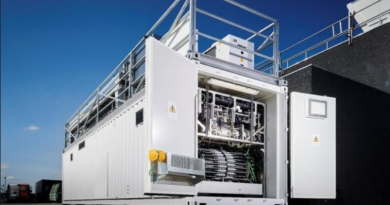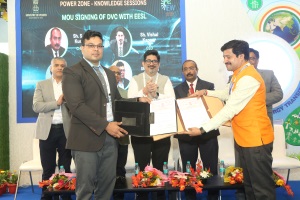Indian Carbon Market: CSE Report Recommends High Floor Price
 Indian Carbon Market: CSE Report Recommends High Floor Price
Indian Carbon Market: CSE Report Recommends High Floor Price
The Center for Science and Environment (CSE) has now released a report on the pathway towards the creation of Indian Carbon Market. The report aimed to collate a clear set of learnings from past and present compliance-based emission trading schemes worldwide, including those operating in India. This learning would help facilitate effective operationalisation of carbon markets in India, further ensuring they serve their intended purpose of reducing emissions, it said.
The report analysed four Emission Trading Schemes (ETS) in use worldwide: the European Union Emission Trading System, the Korean ETS, the Chinese ETS, and the Surat ETS. India’s Perform, Achieve, and Trade (PAT) scheme, which specified energy reduction targets over three-year cycles, has also been assessed as it sets the base for the upcoming Indian Carbon Market scheme. The report highlighted the challenges in the PAT scheme, which include excess availability of ESCerts, lenient targets and delayed compliance.
“We have found that in 2016, the Indian steel sector emissions stood at 135 million tonne (MT) of CO2 while it managed to reduce an average of only 2.5 MT of CO2 emissions per year between 2012 and 2020 (as per BEE data) — the sector reduced a mere 1.85 per cent emissions in a year. Similarly, the cement sector’s reduction was less than 1 per cent, while the power sector managed to cut down 2.3 per cent of its overall CO2 emissions of 2016 over a span of 6 years. Our analysis has highlighted the challenges in the PAT scheme, which include excess availability of ESCerts, lenient targets and delayed compliance. The newly proposed Carbon Credit and Trading Scheme (CCTS) which aims to build on PAT’s framework, needs to address these shortcomings,” says Parth Kumar, programme manager, industrial pollution, CSE.
Nivit Yadav, programme director, industrial pollution, CSE said, “The PAT scheme was initiated with the good intention of increasing energy efficiency in industrial sectors, but faced several shortcomings in implementation. Our analysis shows it has achieved marginal emissions reduction, which is not enough as India attempts to travel towards decarbonisation, especially in the hard-to-abate industries.”
Moreover, in its PAT assessment, CSE has analysed emissions reductions in the power, steel and cement sectors. Speaking on the issue CSE director general Sunita Narain said: “The upcoming Indian Carbon Market scheme should kick start with a large coverage of the country’s emissions. A single nation-wide carbon market scheme for carbon-intensive sectors should be brought in to ensure effective implementation and avoid any complexity.”
The CSE report also talked about a slew of challenges for the proposed new scheme. Some of these challenges will include–low price of carbon credit and low market liquidity, Unambitious target setting, dependence on the PAT scheme, no revenue generation, data quality and others. CSE in its report also put forth a number of recommendations to make the whole process streamlined.
Some of the recommendations included–
- Reduce complexity and have a single nation-wide scheme for carbon-intensive sectors: It is essential to free the carbon-intensive sectors from the PAT scheme at the earliest, so that CCTS is the only nation-wide scheme for these sectors, leaving no room for mismanagement and confusion. “The selection of obligated entities from high-emitting industrial sectors should not be based on the PAT cycle: this can reduce the effectiveness of CCTS in its initial phase. Having a single nation-wide scheme for carbon-intensive sectors will enable the biggest polluters and a large number of entities to be given CCTS targets from the very beginning. This will bring a collective zeal and coherence in the sector, and the feeling that all are moving towards a single goal,” notes Kumar.
- Ensure a stable, high carbon price: To do this, it is essential for the upcoming carbon market to set ambitious targets, establish market stability mechanisms, set up a high floor price and implement sizable penalties effectively. Voluntary credits should be limited to less than 5 per cent and should be of high integrity.
- Ensure data quality and improved transparency: To avoid data fraud as seen in the Chinese ETS, India must consider introducing heavy penalties and rigorous monitoring cycles for the obligated entities — China has done it in its 2024 regulation. It is also essential to build the capacity of carbon verifiers, involve multiple agencies in this job, and increase their numbers to ensure smooth data collection and MRV. It is essential to share reporting data in the public domain, which would then shield the data from manipulation.
- Introduce revenue generation to support MSMEs: The current Indian carbon market model lacks revenue generation mechanisms — it is crucial to devise methods to generate revenue from the scheme, which could fund MSMEs. A system (technological and financial) needs to be developed to support the MSME sector under CCTS to create a level playing field for them.
- Consider inclusion of thermal power sector: To address the significant contribution of the power sector to greenhouse gas emissions and to ensure effective progress towards India’s NDC targets, it is imperative to include the power sector in the carbon market scheme. The sector’s continuation under the PAT scheme might not be enough for the future needs of decarbonisation.
“Power plants have shown subpar performance when it comes to meeting deadlines, targets of current schemes in the sector like meeting SOx emission norms, biomass co-firing and others. Inclusion of thermal power plants in the CCTS will give an added push for power plants to implement emission reduction policies like biomass co-firing and other upcoming policies. ” adds Yadav.




